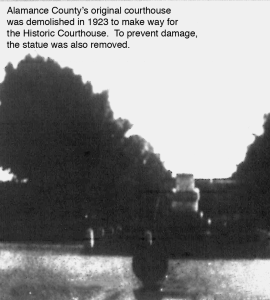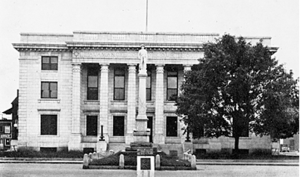 Over the years, there have been persistent rumors of a fire which destroyed the original courthouse. However, no documentation or news reports from the time indicate that the courthouse burned down. The reason for its demolition was much simpler: it was a very small building and Alamance County was a growing community, and was demolished in 1923.
Over the years, there have been persistent rumors of a fire which destroyed the original courthouse. However, no documentation or news reports from the time indicate that the courthouse burned down. The reason for its demolition was much simpler: it was a very small building and Alamance County was a growing community, and was demolished in 1923.
The historic courthouse’s cornerstone was laid on November 17, 1923. William Arnold amd James Lexie Moore, brothers of Sheriff Hallie Moore, dug the foundation for the Historic Courthouse in 1924 using mules and dragpans.
Just over a year later, on November 23, 1924, the courthouse was dedicated by Judge W. A. Devin. At the time, the 4-story courthouse was considered to be one of the best examples of modern architecture in the state of North Carolina, and the $253,925.82 cost – or $3.16 million in 2009 dollars – reflected that.
The Historic Courthouse is an example of Neoclassical Revival Style architecture, a popular style for government buildings in the United States during the early 1900’s. Other examples can be seen in buildings like the White House and the Lincoln Memorial. It can also be viewed in the Old Guilford Courthouse and in other courthouses designed by architect and Greensboro resident Harry Barton, who designed our own Courthouse.

The courthouse features some unique elements:
- While the original courthouse had its first floor at street level, the Historic Courthouse features a raised first story sitting above a basement area used for small claims court and records storage.
- The top of the courthouse features a flat roof concealed by a parapet wall and balustrades.
- The porticoes on the north and south sides of the courthouse each feature six fluted Doric columns, each topped with acanthus and palmette flourishes. They also feature the words Alamance County Courthouse at the top of each portico.
- On the east and west sides of the courthouse, the colums are replaced with 4 matching pilasters.
- Each entrance features stairs built into the granite foundation, columnar iron lamps, and doorways with entablatures resting on scroll consoles and decorated with a crest of anthemion and palmette antefixes.
- Throughout the external structure, you will see numerous decorative friezes and other flourishes.
- The terracotta stonework features multiple, subtle colors throughout the structure. This is best seen in the columns on the north and south sides
